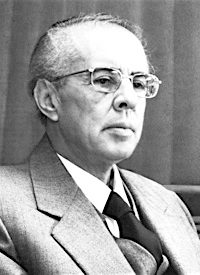
Last month, while still in the midst of turmoil, the people of Albania commemorated the 20th anniversary of the alleged fall of Communism in their country. On February 20, Albania’s ruling Democratic Party, led by Prime Minister Sali Berisha, announced to a crowd of 300,000 supporters in the capital city of Tirana that just 20 years earlier “Albania managed to bring down the fiercest communism regime in Europe,” referring to the 40-year reign of communist dictator Enver Hoxha.
“The fall of communism is one of Albania’s greatest victories,” Berisha proclaimed, “and I call all Albanians to join us in order to make Albania worthy of [membership in] the European Union.”
“No one should dare to reverse by violence a democratic state, as the former communists’ sons wanted to do on January 21,” the Prime Minister continued, taking the opportunity to refer to Albania’s current protest demonstrations led by the opposition Socialist Party. “You cannot come to power by force,” he asserted.
The Socialist Party of Albania is the current successor to the communist Party of Labour of Albania, which presided as the country’s single ruling party from 1946 to 1992.
Communist Albania
For much of that time, Albania was ruled by Enver Hoxha (photo, above), the First Secretary of the Albanian Party of Labour — a position he held until his death in 1985.
Born on October 16, 1908, Hoxha was regarded as a ruthless dictator who micromanaged the affairs of the state and its population with an iron fist through his ideology of Hoxhaism — an anti-revisionist Marxist-Leninist blend of communism. Closely related to Stalinism, Hoxahism has historically been regarded as a break from Maoism.
One of the great myths of the Cold War was the so-called “split” among the Soviet Union, the People’s Republic of China, the Socialist Federal Republic of Yugoslavia, and the Socialist People’s Republic of Albania.
Soviet-Albania “Split”
Although “Khrushchev denounced the Albanian leaders publicly at the Twenty-second CPSU Congress in October 1961 for their criticisms of the Soviet party program, for their dogmatic Stalinism, and for their rejection of peaceful coexistence,” KGB defector Anatoliy Golitsyn explained in his book New Lies for Old (1984), Hoxha nevertheless expressed “through the Albanian party press his party’s continuing solidarity with the CPSU [Communist Party of the Soviet Union].”
As Hoxha affirmed his continued support for the CPSU, he also took the opportunity to respond to the attack from “Khrushchev and his group,” declaring that they were betraying Leninism; “that they were restoring capitalism in the Soviet Union; that they were conducting an opportunistic policy of concessions to, and cooperation with, imperialism; and that they were conspiring with the leading revisionist, Tito,” Golitsyn wrote.
What followed from this was a “split” in Soviet-Albanian diplomatic relations commencing in December 1961, resulting in Albania’s withdrawal from the Warsaw Pact in 1962 and terminating its participation in the Soviet-led Comecon international meetings. This split, however, was only superficial — designed to misinform and deceive the West about the true amalgamation of international communism and Soviet strategic leadership abroad.
Golitsyn, who was a member of the highly classified “inner” Department D of the KGB — which oversaw and implemented the strategic long-range disinformation campaign for the Soviet Union — revealed that as of late 1959, “the KGB’s disinformation department was actively collaborating with the Central Committee’s Department of Active Operations and with the Yugoslav and Albanian security services in joint disinformation operations.”
Department D, the KGB’s disinformation group, was created in 1959 by then-Chairman of the KGB Alexander Shelepin.
“The effect of Shelepin’s instructions,” Golitsyn continued, “was to make Albania a party to a triangular disinformation operation with the Soviet Union and Yugoslavia, an ingenious method of turning to the advantage of the bloc’s long-range policy the earlier genuine disputes and difficulties in relations between the three countries. … The strategic considerations the bloc leaders would have had in mind when planning this operation would probably have been both internal and external.”
Golitsyn explained the logic of such a campaign:
A disinformation operation to which both the Yugoslav and Albanian leaders were parties offered substantial advantages by providing scope for intimate secret collaboration between the party leaders in an operation of importance to the whole bloc while at the same time providing a means of delaying open acknowledgment of their secret reconciliation to the party rank and file and to the populations at large.
During this time, Soviet leader Nikita Khrushchev came to realize the strategic value of involving genuine dissenters, communists that were anti-Soviet, Maoists, Trotskyites, and victims of Stalin’s purges, in the Soviet Union’s new long-range policy. By using these opposition elements, he would assure that the Soviet Union would keep a watchful eye over them as they carried out active measures against the “imperialist” West — thereby neutralizing them as a direct threat to the Soviet Empire.
Any and all types of communists — whether Marxist-Leninists, Trotskyites, Maoists, Stalinists, Kádárists, Titoists, or Hoxahists — would play a vital role in aiding the Soviet Union to achieve its strategic objectives.
Just as the KGB used many such various groups as the Communist Party USA (CPUSA), the Socialist Workers Party, the Black Panthers, the Weather Underground, FALN Puerto Rican terrorists, anarchists, and other anti-war leftist activists in order to bring about revolution and terror in the United States, Khrushchev and the KGB sought the same approach with various Communist and other anti-Western states. The result was the deception of the “split” between the Soviet Union and the previously-mentioned states of Red China, Yugoslavia, and Albania.
In regard to Albania’s role in this long-range deceptive strategy, Golitsyn noted:
The inclusion of the Albanian leaders was the logical next step. They too could be actively involved in, and committed to, the new policy. A disinformation operation embracing a calculated, spurious dispute with the Soviet Union gave them the opportunity to project themselves to their own people and to enhance their own and their party’s prestige as an independent national force robust enough to stand up to Khrushchev’s bullying interference in their affairs…
Given Albania’s past alignment with Stalin in the genuine Tito-Stalin split and Western knowledge of that alignment, it would have seemed logical and convincing to make Albania a “Stalinist” country in partnership with the Chinese in a calculated and controlled dispute with the Soviets. It also served as a useful preliminary move toward a more open and official Soviet-Yugoslav alignment from 1961 onward, in apparent opposition to the Sino- Albanian partnership.
Because of Albania’s small size and relative geographical detachment from the Soviet Union and the other Warsaw Pact satellite states, it was a “particularly suitable choice to be the first full member of the bloc to split away from the Soviet Union after 1958,” Golitsyn stated, adding:
The Soviet-Albanian “split” should in fact be regarded as a pilot project for the much more significant Sino-Soviet split, which must already have been in the preliminary stages of development. It gave the bloc strategists an opportunity to test the validity of their disinformation concepts and techniques and to examine the internal and external consequences of a spurious minor split before committing themselves finally to a spurious major split between the Soviet Union and China. [Emphasis added.]
The most significant event relatec to Soviet-Albanian strategic relations occurred in November 1960 when Hoxha became a proud signatory to the Manifesto of the Eighty-one-Party Congress, at which time he pronounced that “the hopes of the imperialists, headed by the USA, to split the communist camp are doomed to failure.”
Hoxha’s Albanian Party of Labour espoused nothing but the utmost support for and solidarity with the Soviet Union and China in an official report to its Fourth Congress, published February 14, 1961, 11 months before the alleged “split” between the Soviet Union and Albania, which — based on the Manifesto of the Eighty-one-Party Congress and the revelations of the KGB’s Department D, as exposed by KGB Department D defector Anatoliy Golitsyn — was in actuality a centrally-planned component of the Soviet Union’s long-range policy.
Albania’s 2011 Protests
Although Albania may no longer be a communist republic ruled by Hoxha, its former ruling Stalinist party (now allegedly turned Trotskyite-Socialist) remains a potent force to be reckoned with as it currently incites “anti-Mubarak-style” mass protests and demonstrations against the democratic government of President Bamir Topi and Prime Minister Sali Berisha. The Socialist Party is demanding the resignation of the President, the Prime Minister, and the entire Parliament in the hopes that the spirit of democracy will pave the way for its ascension to power in a new round of early elections.
For the time being, the Albanian government remains steadfast in refusing to give in to the demands of the Socialist protesters, attempting to ensure that the country does not regress to the Stalinist state it once was under the rule of Soviet proxy dictator Enver Hoxha and his communist successor Ramiz Alia 20 years ago.
Related Articles:



